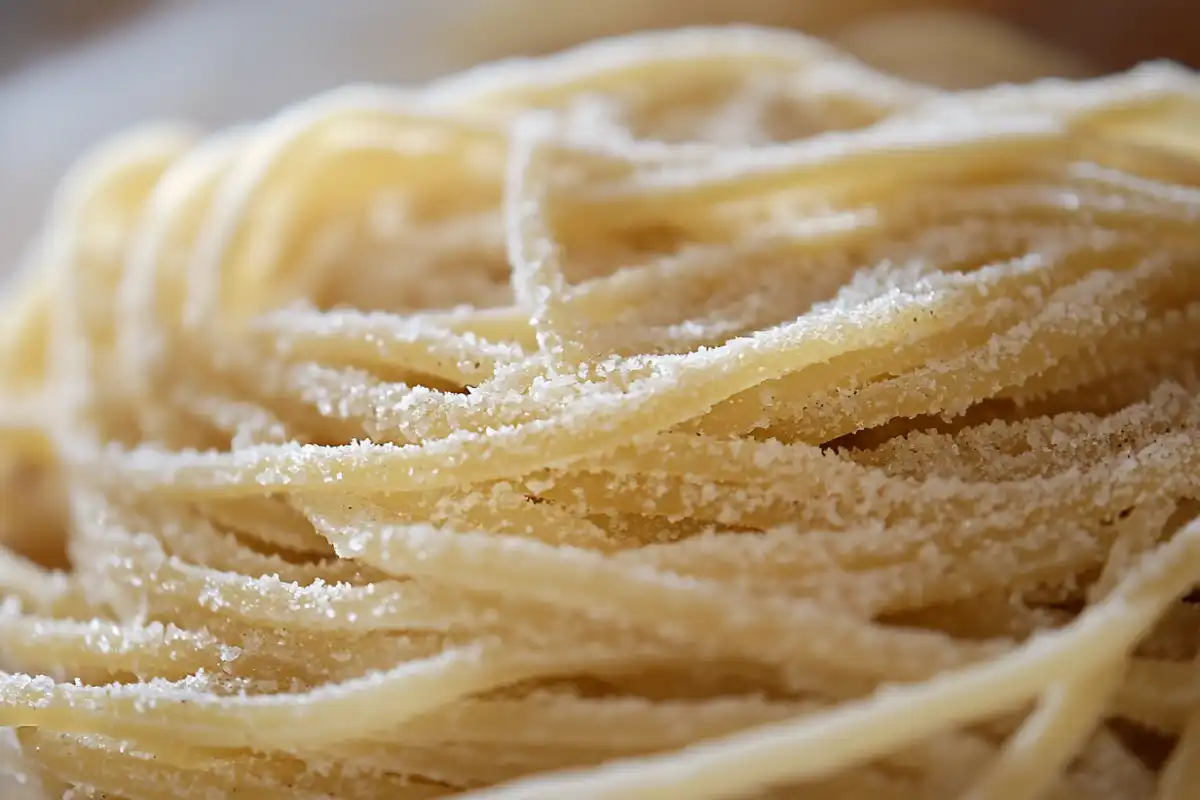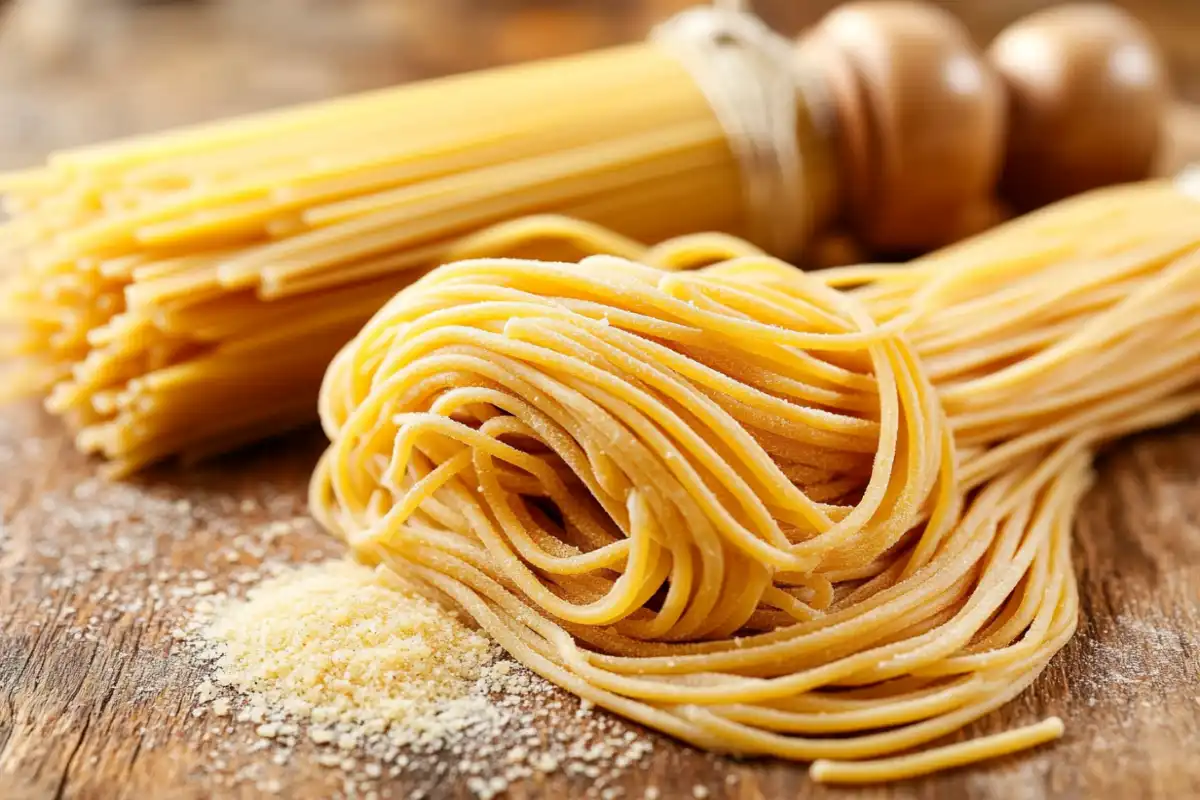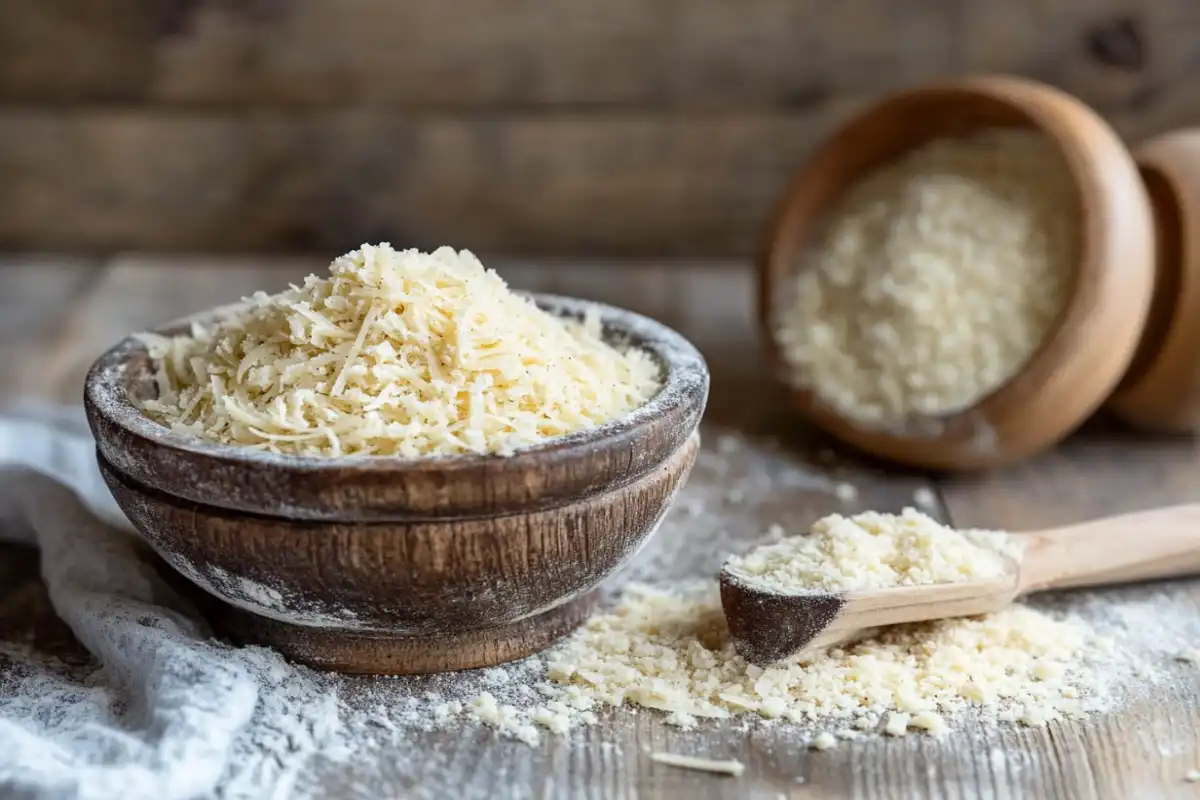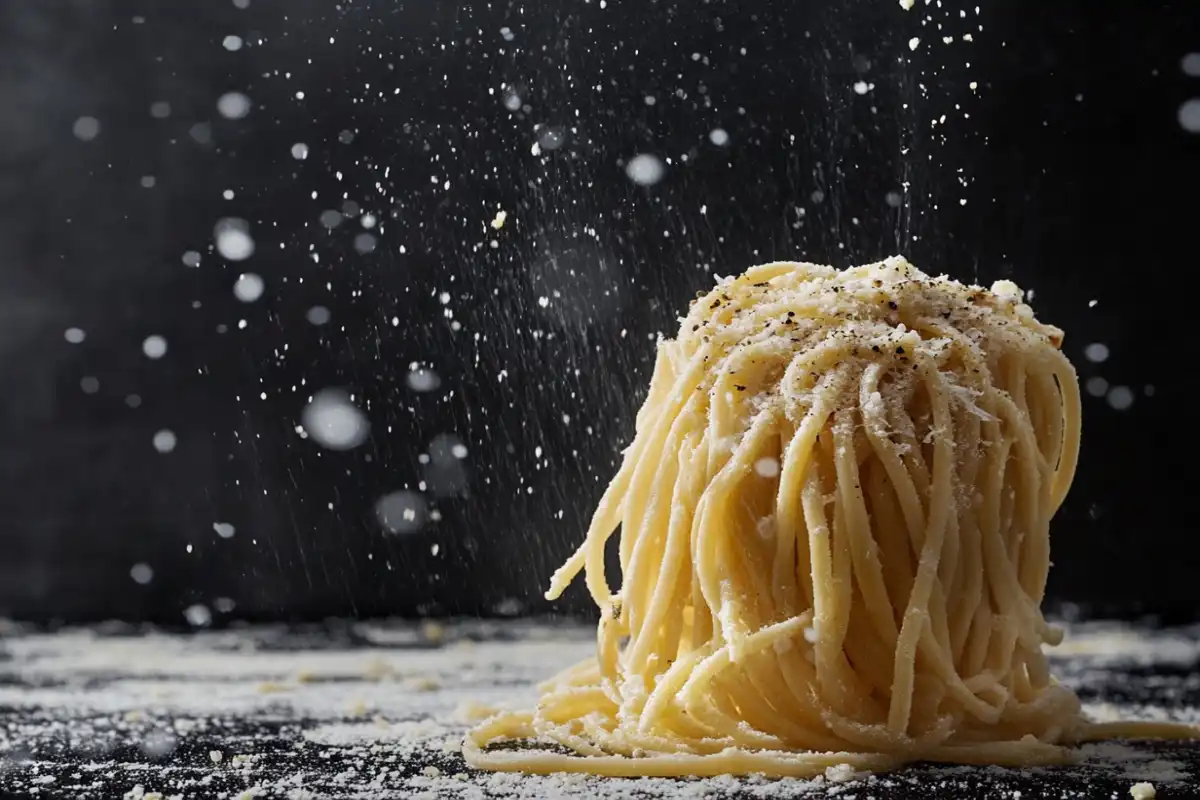What does cacio e pepe mean in Italian?
In Italy, Bucatini Cacio e Pepe is a standout dish from Rome. It’s loved by many around the world for its simple yet rich taste. Let’s explore what makes this dish special and why it’s a true taste of Rome.

Key Takeaways
- Cacio e pepe is a classic Roman pasta dish made with just a few simple ingredients
- The name “cacio e pepe” translates to “cheese and pepper” in Italian
- The dish’s origins can be traced back to the pastoral traditions of Roman sheep herders
- Pecorino Romano cheese and black pepper are the signature flavors that define cacio e pepe
- Mastering the technique of creating a creamy, emulsified sauce is key to achieving the perfect cacio e pepe
What Does Cacio e Pepe Mean in Italian?
“Cacio e pepe” is a key part of Italian cooking, known as a classic Roman pasta dish. It comes from “cacio” (Pecorino Romano cheese) and “pepe” (black pepper). This recipe is loved for its simple yet rich flavors, making it a favorite in Italian food.
Understanding the Traditional Roman Pasta Dish
Cacio e pepe shows the clever cooking of Roman sheep herders. They made tasty meals with what they had. The sharp cheese and peppery flavor mix to create a comforting dish.
Cacio e Pepe: A Simple Yet Flavorful Classic
Cacio e pepe is all about simplicity. It needs just a few things: pasta, Pecorino Romano, black pepper, and pasta water. Yet, it turns into a creamy, peppery, and satisfying pasta dish that’s a classic in Italy.
The Origins of Cacio e Pepe
The roots of cacio e pepe are in central Italy’s rural areas. Sheep herders used Pecorino Romano cheese and black pepper for meals. Today, it’s a symbol of Italian food’s rich history and traditions.

Decoding the Meaning of “Cacio e Pepe”
“Cacio e pepe” is a key part of Roman cooking, filled with cultural meaning. It comes from “cacio” (meaning Pecorino Romano cheese) and “pepe” (meaning black pepper). This dish shows the heart of the region’s cooking traditions.
The dish centers on Pecorino Romano cheese, a hard, salty cheese made from sheep’s milk. It’s been made in the Roman countryside for centuries. When paired with black pepper, these ingredients create a perfect mix of flavors. This mix is a hallmark of Roman cooking.
“Cacio e pepe is a true representation of the Roman culinary tradition, where simplicity and quality ingredients are the keys to extraordinary flavor.”
The name “cacio e pepe” truly captures the dish’s essence. It shows the dish’s authenticity by highlighting its main ingredients. This naming tradition honors the traditional Roman cooking passed down through generations.

Understanding “cacio e pepe” helps us appreciate its rich culinary heritage. In a world of fleeting culinary trends, cacio e pepe’s lasting popularity shows its timeless appeal. It proves that simple, yet exceptional, traditional Roman cooking can still captivate us.
Bucatini Cacio e Pepe: The Iconic Roman Sheep Herder’s Pasta
At the heart of Roman cuisine lies the quintessential dish of cacio e pepe. It’s a simple yet flavorful pasta that has captivated the culinary world. The classic recipe uses bucatini pasta, a unique hollow spaghetti-like noodle.
The origins of cacio e pepe trace back to Roman sheep herders. They used Pecorino Romano cheese and black pepper for a satisfying meal. The hollow bucatini pasta was perfect for their active lifestyle.
“Bucatini cacio e pepe is the quintessential Roman sheep herder’s dish, a testament to the ingenuity and resourcefulness of the local culinary tradition.”
Over time, this dish evolved from a humble shepherd’s fare to a key part of Roman cuisine and traditional Italian recipes. The mix of thick bucatini, sharp Pecorino Romano, and bold black pepper is iconic.
Today, bucatini cacio e pepe is a beloved staple in Rome. It shows the lasting appeal of traditional Italian recipes. It delights locals and visitors alike, symbolizing the city’s rich culinary heritage.
The Key Ingredients of Cacio e Pepe
Cacio e pepe is a beloved Roman dish. It’s made with Pecorino Romano cheese and black pepper. These ingredients come together to create a unique flavor, showing off Rome’s rich culinary traditions.
Pecorino Romano: The Signature Cheese
Pecorino Romano is the star of cacio e pepe. This hard, aged sheep’s milk cheese comes from Lazio, Italy. It has a tangy, salty taste that complements the dish’s simplicity.
Its creamy texture melts into the pasta, making a velvety sauce.
Black Pepper: The Spice That Brings the Heat
Freshly cracked black pepper is key in cacio e pepe. It adds a pungent, peppery flavor. This spice contrasts with the cheese, adding heat and depth.
This mix of flavors makes cacio e pepe a true celebration of Roman cooking.
Pecorino Romano and black pepper are the heart of this iconic pasta. They show the simplicity and brilliance of Roman cuisine. By mastering these ingredients, home cooks can enjoy the authentic flavors of this classic dish.
Mastering the Technique of Cacio e Pepe
Cacio e pepe is a dish that needs both skill and tradition. It comes from Rome’s rich food history. To get it just right, you must focus on the creamy texture and the flavors.
The secret to cacio e pepe is the emulsion. Mixing pasta water, Pecorino Romano cheese, and black pepper creates a smooth sauce. This sauce sticks to the pasta, offering a mix of salty and peppery tastes.
- Choose the right pasta: Bucatini, spaghetti, or tonnarelli work best. Their long shapes fit the sauce perfectly.
- Cook the pasta until it’s al dente. Save a lot of the starchy water before draining.
- Add Pecorino Romano cheese and hot pasta water slowly. Whisk constantly to mix well.
- Remove from heat and add black pepper. Adjust the seasoning as needed.
- Mix the pasta with the sauce. Add more water if it’s too thick.
Mastering this cacio e pepe recipe requires patience and skill. By following Roman traditions, you can make this Italian pasta dish even more delicious.
“The true essence of cacio e pepe lies in the harmony of just a few humble ingredients, expertly combined to create a culinary masterpiece.” – Chef Dominico Catalano, renowned Roman chef
Variations and Modern Twists on Cacio e Pepe
The classic cacio e pepe dish has won the hearts of pasta lovers around the world. Chefs are now trying new things with this old recipe. They’re using different pasta shapes and adding new ingredients, making cacio e pepe even more exciting.
Exploring Different Pasta Shapes
While bucatini is the usual choice, chefs are now using spaghetti, rigatoni, fusilli, and even gnocchi. Each shape brings a unique feel and pairs well with the classic flavors of pecorino and black pepper.
Adding Complementary Ingredients
Modern twists also include new ingredients. Some add crispy pancetta or guanciale for a salty kick. Others use lemon zest or fresh herbs to add brightness. These changes make cacio e pepe appealing to a wide range of tastes.
| Cacio e Pepe Variation | Pasta Shape | Additional Ingredients |
|---|---|---|
| Classic Cacio e Pepe | Bucatini | Pecorino Romano, Black Pepper |
| Spaghetti Cacio e Pepe | Spaghetti | Pecorino Romano, Black Pepper |
| Rigatoni Cacio e Pepe | Rigatoni | Pecorino Romano, Black Pepper, Crispy Pancetta |
| Fusilli Cacio e Pepe | Fusilli | Pecorino Romano, Black Pepper, Lemon Zest |
| Gnocchi Cacio e Pepe | Gnocchi | Pecorino Romano, Black Pepper, Fresh Basil |
The world of cooking is always changing, and cacio e pepe is no exception. It shows how creative and innovative Italian cuisine can be. Whether you stick with the original or try something new, there’s always something exciting to discover.
Cacio e Pepe: A Taste of Roman Culinary Tradition
Cacio e pepe is more than a simple pasta dish. It’s a key part of Rome’s rich culinary heritage and Italian food culture. This classic Roman cuisine has become a favorite worldwide. It brings a taste of the traditional pasta dishes that define Rome’s food identity.
The dish’s heart is its two main ingredients: Pecorino Romano cheese and black pepper. Together, they create a flavor that shows the cleverness of Roman shepherds. They made a delicious meal from simple pantry items.
“Cacio e pepe is not just a dish, it’s a story – a narrative of the enduring spirit and culinary traditions of the Roman people.”
Cacio e pepe takes you back to Rome’s sunny piazzas and streets. The smell of black pepper and Pecorino cheese fills the air. It’s a culinary journey that captures the heart of Roman cuisine and Italian food culture.
In Rome or kitchens worldwide, cacio e pepe shows the beauty of simplicity. It’s a dish that celebrates the traditional pasta dishes that have lasted through time. It invites us to enjoy the flavors of the past and honor the rich culinary traditions of Italian gastronomy.
Pairing Cacio e Pepe with the Perfect Wine
Finding the right wine for cacio e pepe is key. It must match the bold, umami flavors of Pecorino Romano cheese and black pepper. The creamy, peppery taste of this dish needs a wine that balances and enhances it.
Central Italian white wines like Orvieto or Frascati are great choices. They are light, crisp, and have a high acidity. This freshness cuts through the dish’s richness. Their citrus and stone fruit notes also complement the Pecorino well.
For a bolder choice, try a medium-bodied red wine. Chianti or Montepulciano d’Abruzzo work well. Their acidity and fruit flavors can handle the peppery kick of cacio e pepe. This creates a delightful mix of flavors.
| Wine Pairing | Tasting Notes | Why It Works |
|---|---|---|
| Orvieto or Frascati | Crisp, minerally white wines with citrus and stone fruit notes | The high acidity and freshness balance the richness of the cacio e pepe, while the fruit flavors complement the Pecorino Romano. |
| Chianti or Montepulciano d’Abruzzo | Medium-bodied red wines with moderate tannins | The acidity and subtle fruit flavors of these red wines can stand up to the peppery kick of the cacio e pepe, creating a harmonious pairing. |
When looking for wine to pair with cacio e pepe, aim for a wine that complements without overpowering. The right pairing can take this classic Italian cuisine dish to new heights.
Cacio e Pepe: A Timeless Italian Comfort Food
Making cacio e pepe at home is a fun cooking journey. This classic Roman dish is loved for its simplicity and rich flavors. With a few tips, you can make this dish perfectly, enjoying its creamy and peppery taste.
Recreating Authentic Cacio e Pepe at Home
The secret to great cacio e pepe is using top-notch ingredients and the right technique. Choose the best Pecorino Romano cheese and fresh black pepper. Use quality bucatini or spaghetti, and you’ll get close to Rome’s authentic taste in your kitchen.
Tips for Achieving the Perfect Texture
Getting the creamy texture of cacio e pepe is an art. Save some pasta water to mix with the cheese for a smooth sauce. Work fast and gently to avoid lumpy cheese. Add pasta water if needed to get the right sauce consistency.
Serving Suggestions and Presentation Ideas
Best to serve cacio e pepe hot, when the cheese is creamy. Serve it in a big, shallow bowl to show off the dish’s beauty. Top with black pepper and Pecorino Romano cheese. Pair it with a fresh salad and Italian red wine for a complete meal.
FAQ
What does cacio e pepe mean in Italian?
“Cacio e pepe” means “cheese and pepper” in Italian. It’s the name of a classic Roman pasta dish. It uses Pecorino Romano cheese and black pepper.
What is the traditional Roman pasta dish, Bucatini Cacio e Pepe?
Bucatini Cacio e Pepe is a traditional Roman dish. It’s made with bucatini pasta, Pecorino Romano cheese, and black pepper. It’s known for its simple yet flavorful ingredients and creamy texture.
What are the origins of the cacio e pepe dish?
Cacio e pepe comes from Rome’s culinary traditions. It was a staple for sheep herders. The ingredients, Pecorino Romano cheese and black pepper, were simple and affordable.
What is the significance of Pecorino Romano cheese in cacio e pepe?
Pecorino Romano is key in cacio e pepe. It’s a hard, sharp, and salty cheese. Its flavor and ability to melt make the dish creamy.
How important is black pepper in the cacio e pepe recipe?
Black pepper is crucial in cacio e pepe. It adds a bold, spicy flavor to the rich cheese. Freshly cracked black pepper is essential for the dish’s taste.
What is the key to mastering the cacio e pepe cooking technique?
Mastering cacio e pepe is about emulsifying the pasta water, cheese, and pepper. It requires patience and skill. The goal is a silky, creamy sauce without grittiness.
Are there any modern variations of the traditional cacio e pepe dish?
Yes, chefs and home cooks have made modern twists. They use different pasta shapes and add ingredients like guanciale, lemon zest, or herbs. These changes create unique takes on the classic dish.
How can I pair the perfect wine with cacio e pepe?
Pair cacio e pepe with crisp, high-acidity white wines. Pecorino, Vermentino, or Greco di Tufo work well. They cut through the dish’s richness and complement its flavors.
What tips can I follow to recreate authentic cacio e pepe at home?
For authentic cacio e pepe, use quality Pecorino Romano cheese and freshly cracked black pepper. Emulsify the pasta water with the cheese for a smooth sauce. Cook the pasta right and serve immediately for the best experience.
